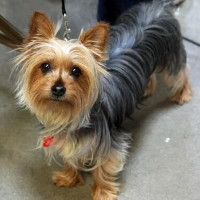Appearance of the Silkshire Terrier
|
| The Silkshire Terrier is a small, lightweight dog with a long, silky coat that looks more like human hair than typical dog hair. Usually weighing less than 4.5 kilos, these compact canines have a small, wedge-shaped head. Their eyes are brown and almond-shaped, and their ears are straight and pointed. The tail is of medium length and may or may not be docked. The most distinctive feature of the Silkshire Terrier's appearance is its coat, which is long, fine and silky. It is generally darker on the back and neck, and lighter on the face and elbows. Coat colors vary and include black and tan, blue and tan and blue and red. |
Temperament of the Silkshire Terrier
|
| Although small in stature, Silkshire Terriers have big personalities. They are intelligent, energetic and alert dogs that cope well in a variety of situations. Silkshire Terriers tend to get along best with older children who understand how to properly handle such a small breed. They can be surly with young children, and many don't get on well with other animals. This breed is known to be an extremely devoted companion, and makes an excellent watchdog. They tend to be rather noisy, which can be problematic for those living in apartments. These dogs are intelligent and respond well to patient, consistent training. However, they are often difficult to housetrain. |
Needs and activities of the Silkshire Terrier
|
| Both the Australian Silky Terrier and the Yorkshire Terrier are energetic breeds. Because of their small size, however, they tire quickly and don't need large play areas. A short walk or a quick game in the garden will be more than enough to sufficiently exhaust your Silkshire Terrier. Because their exercise requirements are limited, these dogs do well in urban areas, including apartments and houses with small gardens. When outdoors, especially in rural areas, they need to be supervised to make sure they don't fall victim to larger animals. Because they are intelligent, Silkshire Terriers also benefit from mental exercise. |
Maintenance of the Silkshire Terrier
|
| Both the Yorkshire Terrier and the Australian Silky Terrier are hypoallergenic, making them ideal hybrids for allergy sufferers. Because Silkshire Terriers have hair as opposed to typical dog fur, they shed very little. Their long coats require high maintenance. This breed needs daily brushing to prevent tangling. Because their coats are more similar to human hair than the coats of most other breeds, these dogs also need more frequent bathing. The coat should be kept about 15 centimeters long, and should not touch the ground. Some Silkshire Terriers need trimming about twice a year. Their hair needs to be kept out of their eyes, either by putting it in a bun or having it trimmed. Their ears should be cleaned regularly to remove excess waste and other debris. Teeth should also be brushed regularly and nails carefully trimmed. |









 English (United Kingdom)
English (United Kingdom)